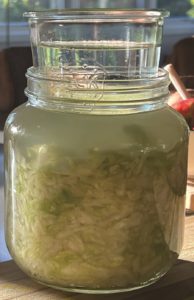The change of seasons has been gentle this year, but with Thanksgiving ahead my mind roams to cold weather meals. And especially to ones that overcome loneliness as much as they do hunger. Like choucroute garni.
Being in France last month with my nephew, Max, who is studying there — or more precisely leaving him there to fend for himself in a new place — must have awakened the memory of this dish.

I first ate it in Strasbourg, in the northeast corner of France — historically Alsace — in a just slightly rundown bistrôt, where I had wedged myself into a table for one, the last available spot in a room filled to overflowing. The windows were fogged, candles flickered in old jars, and, despite the icy wind outside, the mood was bright.
It was just days before Christmas, and I had made the trip by myself, from Paris, where I was studying. All my friends were traveling or with their parents for the holiday break. But my family was in Louisiana and going home would have been an impossible extravagance. Besides, my parents were busy with their teetering marriage and finances, so while I might have felt lonely, I was also relieved to be far from home that year.
Here I would see Strasbourg’s fabled gothic Cathedral. My orange Let’s Go guide, reassuringly fat with recommendations, was the traveling companion I didn’t have.
What the waiter set before me was my first encounter with sauerkraut that was not from a can and carelessly sloshed onto a hot dog. On top of a pile of golden cabbage lay garlicky sausages and slices of pork. It tasted of smoke and earthy spice. Alongside, to balance the richness of all that meat, were a pan of small boiled potatoes and crocks of sharp mustard and pickles.
I might have gotten a little tipsy, but the tables were close together, and it seemed to me my neighbors were not keen on the idea of my dining alone that evening. I warmed to the hubbub. The party to my left was made up of four students from the local university, out with their families. Questions were posed. Toasts were offered. I was cheered.
Sometimes the best thing to do is focus on what’s right in front of you and take comfort from it.
Mark Bittman’s recipe in the New York Times convinced me that choucroute garni could be made at home — even on Cape Cod. The pork extravaganza itself and its foundational element, sauerkraut, are easy. For the former, the magic happens in the oven. For the latter, in a jar.
A little extra effort is needed to ferment your own sauerkraut for this, but the end result makes it worthwhile. And the timing is just right to make the sauerkraut now and let it ferment for a few weeks while we await the cold snap that calls for the coziness of a choucroute garni.
Homemade Sauerkraut
Makes one quart

1 medium head green cabbage, rinsed and trimmed of wilted outer leaves
2 cloves garlic, finely minced
1 Tbsp. kosher (non-iodized) salt
- Remove and set aside one large outer cabbage leaf to use for keeping sauerkraut submerged in the brine. Quarter the cabbage, remove the core, and slice each quarter into thin ribbons. For a quart of sauerkraut set aside one and three-quarter pounds of sliced cabbage in a large bowl.
- Sprinkle the salt onto the cabbage and massage it in using your hands. Don’t be gentle — really work it in. You’ll see liquid begin to gather in the bowl. Once the cabbage begins to release its liquid it will become more compact. One handful of cabbage at a time, pack the salted cabbage firmly into a clean quart jar, pressing to compact it. The jar will fill with liquid as you press. Leave about 1 inch of space between the top of the cabbage and the top of the jar. Use liquid remaining in the bowl to completely submerge the cabbage.
To prevent shards of cabbage from floating out of the brine, take the reserved whole leaf and cut it to just fit the circumference of the jar. Press it down into the jar and then on top of it place a smaller jar (a 4-oz. jelly jar is perfect) right on top of the leaf. Fill this jar with water to weigh down the cabbage. The goal is to have enough brine to cover and protect the fermenting cabbage by keeping it in an anaerobic environment. - Set the jar in a bowl to catch any brine that overflows as lactic fermentation begins and leave on the counter, covered with a kitchen towel, for 24 hours. At this point the cabbage should remain compressed when you remove the weight. Screw on the lid but do not tighten it, so that carbon dioxide resulting from the fermentation can escape. Store the jar in the refrigerator and allow the sauerkraut to ferment for at least 2 and up to 4 weeks. After the first week, you may tighten the lid.
Braised Sauerkraut with Pork (Choucroute Garni)
Serves 4
½ head green cabbage, core removed and sliced
1 quart sauerkraut
6 slices smoked bacon, chopped
2 large onions, peeled, halved, and sliced thin
4 bay leaves
1 Tbsp. caraway seeds or juniper berries
Fresh black pepper
1 lb. boneless pork shoulder, or substitute pork chops
1 lb. smoked sausage, cut into 3-inch pieces
½ bottle dry riesling (or other dry white wine)
2 cups chicken stock
Salt
Freshly ground black pepper
1½ pounds small white potatoes, boiled
Sharp mustard
Cornichons or other pickles
- Heat the oven to 300° F. Sauté bacon until crisp, add onions, and cook until translucent. Scatter raw cabbage in the bottom of a large roasting pan. Top with bacon and onion mixture. Drain the sauerkraut and spread it on top. Tuck in the bay leaves and sprinkle with the caraway seeds or juniper berries and lots of black pepper.
- Place the pork and sausages on top of everything and pour in the wine and stock. Sprinkle the meat with salt and pepper and cover the whole dish tightly with foil. Transfer to the oven to braise, undisturbed, for 2 hours.
- Test the pork shoulder by inserting a fork into the thickest part. When it slides out easily, turn the oven up to 450° F, leave the pan uncovered, and return it to the oven until the meat browns a bit, about 25 to 30 minutes. (If the pork isn’t fork-tender when you test it, re-cover the pan and braise for another 30 minutes before proceeding.)
- To serve, remove the bay leaves and break the pork into chunks. Serve with the boiled potatoes, mustard, cornichons, and hunks of baguette.



